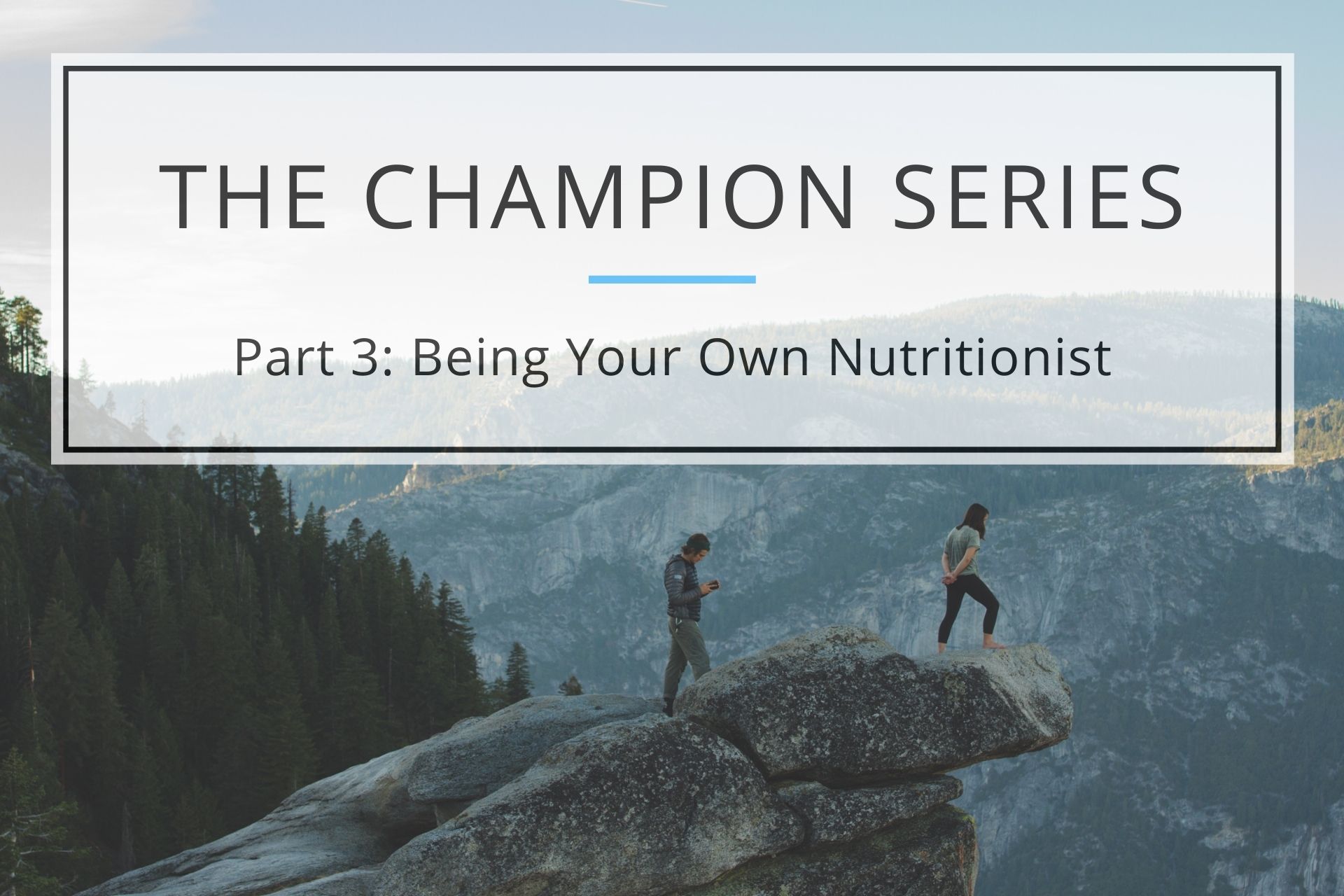
SEPTEMBER 30, 2018: BLOG #6
Being Your Own Nutritionist
Disclaimer: The information you are about to read is based off of my own opinions. Not intended to be taken as professional advice. Just for fun to read and to maybe open up your mind to something new. Enjoy and thanks for taking the time to read my post!
So you stuck it out to Part 3 of my Champion Series. Awesome job! That goes to show that you are motivated to make positive change or at least curious to learn about how this series will end. Either way, it’s great that you want to continue reading!
Many people think becoming an energizer bunny and cranking out intense workouts every day is the way to shed pounds. DEBUNKED – by me. Yes, exercise is great for your body and it’s recommended to incorporate some kind of physical fitness each day. Nutrition also makes up a significant portion of being healthy and getting fit.
You might have already encountered posts or videos explaining the 75 to 25 or 80 to 20 diet to exercise ratio that promotes a fit body. Translation: 75-80 percent of your healthy lifestyle is determined through foods you decide to eat.
One workshop on nutrition that I attended mentioned to think of your body like an expensive car. You don’t put in cheap gas in a luxury car, therefore you should put in healthy foods into your body to keep it in pristine condition.
5 Tips for Healthy Eating (which will also save you money!)
- Eat whole foods as much as possible.
Have you ever taken a glance at the packaging in the everyday common grocery items you purchase? How many times have you read “all-natural”, “real”, “organic”, or other similar words?
At first look, you think “oh, I’m eating healthier because the label on the package told me it was healthy”. But think about the intention of companies and its marketing. Companies have goals to increase sales and get you to continue to buy their products, so they invest much money into their marketing and package design. Not so often do they actually care about your health.
Also, before we had all these processed and packaged foods, plenty of people and communities thrived on whole, real foods. The actual “real” foods from nature. And they aren’t the prettiest because they weren’t brushed up to gleam under the grocery store lights or entice you with their colorful foil designs or boxes; however their nutritional value can’t be beat.
Rule of thumb, try to opt for whole foods as frequently as possible. Things like apples, oranges, eggplants, onions, tomatoes, beans, rice, etc. When buying packaged foods, because sometimes we need a box of pasta or peanut butter, look at the nutrition labels. Things that are listed as 5% or more are high in something, may it be sugars, fats, fiber, iron, you name it. Vice versa, lower than 5% indicates the product is low in something.
Tip: Buy fruits and veggies in season. It’ll help to you to save money as well. Just peruse through those weekly grocery newspapers that you most likely usually dump in the recycling or use to cover tables with whenever you’re doing a messy art project. Then search up recipes online that include the majority of those ingredients.
- Portion out what you eat.
Eat smaller meals throughout the day (like 5 small meals a day). Maybe timing out your breakfast, snack, lunch, mid-day snack, and dinner through tracking in a journal.
Not just that, but portion out the quantity of each food group you have included on your plate. As we all know from grade school education, meals that include each of the major food groups are well-rounded.
Here’s a handy tip to measure your portions (no supplies necessary, just need your hands). Also, you can google these if you’d like a visual representation of the measurements below.
Grains/Carbs: one cupped hand (about ½ cup serving)
Meats: open palm of one hand – not including the lengths of your fingers (about 3 oz serving)
Fruits: one clenched fist (about 1 cup serving)
Veggies: two cupped hands (about 1 cup serving)
Condiments: thumb size (about 1 tablespoon)
Fats and oils: tip of thumb (about 1 teaspoon)
- Add in veggies.
What more can I say? Vegetables are good for you. Have more of it in your diet. Plus, vegetables are a great way to stay full without consuming as many calories as you would if you ate things like cookies or pasta. Vegetables are full of water, which helps with your recommended daily water intake. And incorporating veggies in every meal helps with a smooth movement through your digestive tract because nobody wants constipation.
Note: Potatoes and corn are considered starchy vegetables, which could be great alternatives to grains, rice, or other carbs you consume in your diet.
- Eat out less. Learn to cook and prepare your own meals instead.
Let’s discuss this hypothetical scenario, for a start. And these amounts are based off of calculations for one person. Say you go out every day to eat/buy lunch or dinner. And let’s face it, restaurants and even grocery store ready-to-eat meals can cost you an average of about ten dollars per meal. You eat out for lunch and dinner, that’s almost TWENTY dollars a day. Then multiply that by seven, then you’ve spent $140 a week. At that rate, per month will cost you $560 to eat.
Even just spending ten dollars each day for lunch can cost you an average of $280 per month.
Again, returning to the idea of buying foods in season. Those tend to be cheaper temporarily, so why not use it to your advantage? Budgeting about twenty to thirty dollars for groceries a WEEK can already help you reduce expenses to $140 a MONTH.
I’m not saying that budget might be reasonable for some of you depending on your lifestyle and your daily recommended nutritional intake. You don’t want to starve yourself to save money. It would negate the whole healthy living endeavor. This section is intended to serve as a wake up call to some of you who might be eating out every day.
Try to reduce down eating out to once a week. It’ll make a difference.
As for cooking, this could be a really fun activity once you start. You have control over what ingredients to put into the dish and how much. You control the flavors and if you want to make it like an episode of Chopped, get creative and experiment. I want to encourage you all to expand your palate and the greatest way to reduce calories and add flavor is to invest in a robust spice rack (basil, cinnamon, cumin, black pepper, red pepper flakes, cayenne, etc.). Buy spices you know you can use in a variety of dishes not necessarily rare spices, like kokum or saffron, you would use on occasion.
Last step, google simple, cheap, healthy recipes. I’ve done this before and there are plenty of blogs, websites, even Youtube videos that give you an assortment of meals to cook. Then you can flaunt you new-found cooking skills all over social media because you’re a kick ass boss chef! Or just flaunt it to your friends and family in person.
- Drink water.
As many of you know, the human body is made up of 50-75% water, meaning that water is an essential part of our diet. Water is a low-calorie way that also staves off hunger. Did you know that hunger pangs and thirst pangs are pretty similar? Next time your stomach growls, try drinking some water and determine if you really are hungry. This could also help you from overeating at times.
Regular water, not the one that has added minerals or anything, has a lot of benefits. Staying hydrated helps prevent headaches (yeah, it might not be that annoying friend of yours or work causing those throbbing heads), maintaining tip-top functioning of your physical body (i.e. organs, blood, cell regeneration), keeps you more alert, relieves constipation. So get those 8 cups or more of water in!
Which one of these tips are you going to start trying out today?


